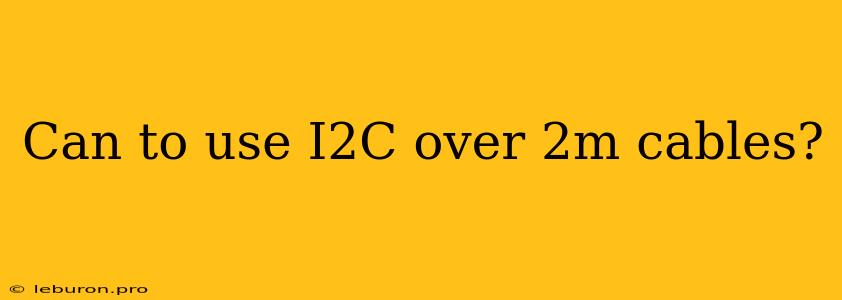Can I Use I2C Over 2m Cables?
The I2C (Inter-Integrated Circuit) protocol is a popular choice for communication between microcontrollers and peripheral devices. Its simplicity, low cost, and ease of implementation make it a popular choice for many applications. However, one common question that arises is: Can I use I2C over 2m cables? The answer, unfortunately, is not a simple yes or no. While I2C was initially designed for short distances, advancements in technology and techniques have allowed for longer-distance communication. This article will explore the factors that affect I2C communication over longer distances, including the challenges, considerations, and potential solutions.
Understanding I2C limitations
The I2C protocol was designed for short-range communication between devices on the same board or within a small enclosure. The standard specifies a maximum distance of 3.96 feet (1.2 meters), with a maximum data rate of 100 kHz. This limitation stems from several factors:
Signal Integrity
I2C utilizes open-drain/open-collector outputs for both data lines (SDA and SCL). This means that the signal is pulled low by the driving device and pulled high by pull-up resistors. As the cable length increases, the capacitance of the cable becomes more significant, leading to signal attenuation and distortion. This can cause timing issues, especially during transitions between high and low levels.
Noise susceptibility
Open-drain outputs are more susceptible to noise interference. Longer cables increase the surface area exposed to electromagnetic interference (EMI) and radio frequency interference (RFI). This can lead to false signals and data corruption.
Timing and Clock Synchronization
Maintaining accurate timing and clock synchronization is crucial for reliable I2C communication. Longer cables can introduce delays, leading to timing discrepancies between the master and slave devices.
Power Considerations
The open-drain outputs also require a pull-up resistor to maintain a high signal level. As the cable length increases, the resistance required to maintain the signal integrity and speed also increases, leading to higher power consumption.
Overcoming I2C Distance Limitations
While I2C was initially designed for short distances, several techniques can be used to extend its reach beyond the standard 1.2 meters.
1. Signal Conditioning
Signal conditioning techniques aim to minimize signal attenuation and noise interference. Common solutions include:
- Shielded Cables: Using shielded cables reduces the impact of external electromagnetic interference.
- Termination Resistors: Terminating the I2C bus with appropriate resistors can minimize reflections and improve signal integrity.
- Voltage Level Shifting: Using level shifters can adjust voltage levels between the master and slave devices, especially when dealing with different voltage supply levels.
2. Bus Repeaters/Extenders
Bus repeaters or extenders act as intermediate devices that amplify the signal and regenerate the clock. They allow I2C communication over longer distances by breaking down the cable into segments, reducing signal attenuation.
3. Specialized I2C Drivers
Some manufacturers offer specialized I2C drivers designed for longer distances. These drivers often incorporate signal conditioning, buffering, and clock management to improve performance and reliability over longer cables.
4. High-Speed I2C Standards
I2C has evolved with standards like I2C Fast Mode (400 kHz) and Fast Mode Plus (1 MHz) that allow for faster data rates. These standards often require more stringent signal integrity requirements and specific driver and receiver components to operate reliably.
5. Alternative Protocols
For truly long-distance communication, using alternative protocols like SPI (Serial Peripheral Interface) or UART (Universal Asynchronous Receiver/Transmitter) might be more suitable. These protocols are generally designed for longer distances and offer greater robustness.
Choosing the Right Approach
When considering I2C communication over extended distances, it's crucial to carefully evaluate the following:
- Distance: The maximum cable length required for your application.
- Data Rate: The required data transfer rate.
- Noise Environment: The level of electromagnetic and radio frequency interference in the environment.
- Power Consumption: The power budget for the system.
- Cost: The cost of implementing the chosen solution.
Conclusion
I2C communication over 2m cables is achievable with proper techniques and considerations. By understanding the limitations of I2C and implementing appropriate signal conditioning, using bus repeaters, or opting for specialized drivers, you can overcome distance limitations and achieve reliable communication even over longer distances. Remember that choosing the right approach depends on the specific needs of your application, and careful evaluation of the factors mentioned above is essential for a successful implementation. Ultimately, the decision to use I2C over longer distances requires a careful trade-off between performance, cost, and complexity.
